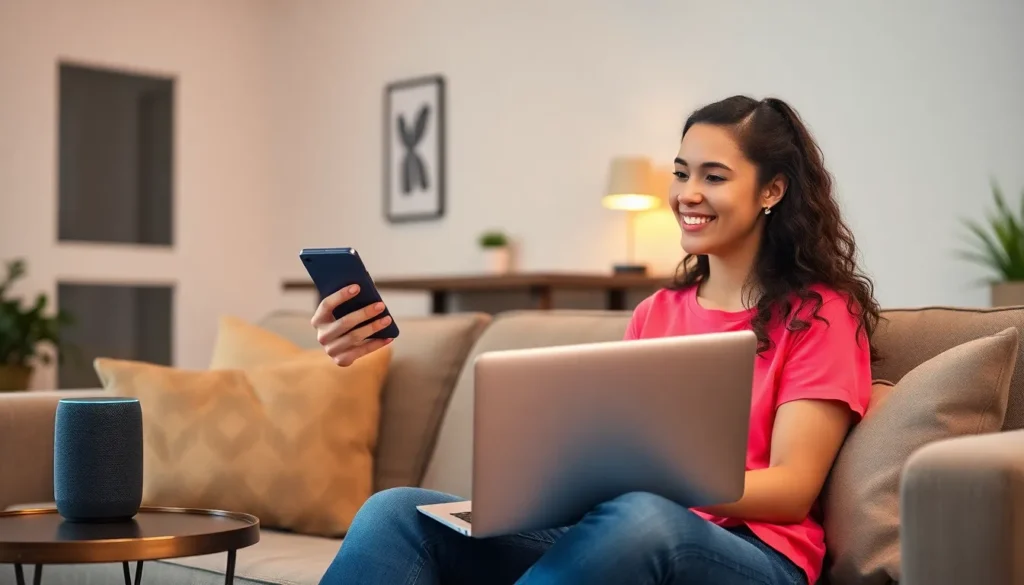In today’s fast-paced world, technology isn’t just a luxury; it’s a necessity that weaves itself into the fabric of everyday life. From the moment the alarm clock buzzes to the last scroll through social media before bed, gadgets and gizmos play a starring role in our daily routines. It’s hard to imagine a morning without a smartphone or a commute without a playlist, right?
But let’s be honest—while technology makes life easier, it can also lead to some hilarious moments. Ever sent a message to the wrong person or accidentally summoned a virtual assistant in the middle of a meeting? These quirks remind us that while tech can be a trusty sidekick, it’s not without its comedic blunders. Dive into the fascinating world of how technology shapes our lives, one laugh (and mishap) at a time.
Table of Contents
ToggleThe Role of Technology in Everyday Life
Technology influences nearly every aspect of daily routines. Smartphones keep individuals connected, allowing them to communicate instantly with others. Smart home devices enhance convenience, managing tasks like adjusting thermostats and controlling lights. Online platforms provide access to information, enabling faster decision-making and learning opportunities.
Social media has transformed how people interact, fostering connections across distances. Notifications from apps can disrupt focus yet also keep users informed about friends and news. Virtual assistants offer hands-free support, allowing users to set reminders and make calls without needing manual input.
In the workplace, collaboration tools improve productivity. Employees share files easily, participate in video conferences, and coordinate projects in real time. Cloud storage solutions enhance accessibility, allowing users to retrieve documents anytime and anywhere.
Health apps track fitness activities, helping individuals maintain healthier lifestyles. Wearable devices monitor heart rates, sleep patterns, and physical activity. These technologies encourage users to achieve their wellness goals with real-time data and insights.
However, reliance on technology can lead to mishaps. Autocorrect functions might change messages unexpectedly, causing confusion. Miscommunication through texting often results in humorous anecdotes among friends and family.
In various domains, technology serves as both an essential resource and a source of entertainment. Gamers enjoy immersive experiences through advanced graphics and interactive gameplay. Streaming services provide access to movies and shows, creating new viewing habits.
The balance between convenience and occasional tech-related mishaps shapes daily life. Whether in communication, health, or leisure, technology plays an irreplaceable role in enhancing experiences.
Communication Advancements

Technology’s impact on communication methods revolutionizes how individuals connect and share information daily. From social media to instant messaging, these advancements shape relationships and community dynamics.
Social Media Influence
Connections thrive on social media platforms. Users update statuses, share experiences, and engage with others in real-time. Statistics reveal that 4.9 billion people engage with social media globally. Social media also plays a vital role in brand marketing, with businesses reaching audiences directly and efficiently. Through influencers, companies can target specific demographics effectively, resulting in increased brand awareness and sales. Real-time feedback enables adjustments in campaigns, demonstrating its power in shaping perceptions.
Instant Messaging Applications
Messages fly across instant messaging applications. With over 2.5 billion users, platforms like WhatsApp and Facebook Messenger facilitate quick conversations and group chats. Features such as voice messaging and video calls enhance communication versatility. Businesses adopt these applications for customer service, reducing response times and improving satisfaction. The shift toward messaging apps provides a convenient alternative to traditional emails, allowing immediate and informal interactions. Enhanced security measures further ensure that conversations remain private, making these applications trusted tools in personal and professional settings.
Smart Home Devices
Smart home devices transform daily living by integrating technology into home management. These gadgets streamline tasks and enhance comfort, making life more efficient.
Home Automation Trends
Home automation trends focus on connectivity and user-friendliness. IoT devices connect seamlessly, allowing users to control appliances and security systems remotely. Voice-activated assistants, like Amazon Alexa and Google Assistant, gain popularity for managing interconnected devices without manual inputs. Smart sensors monitor energy consumption and enhance efficiency, encouraging eco-friendly practices. Analysts project the smart home market could reach $174 billion by 2025, highlighting the growing interest in advanced home technologies.
Benefits of Smart Technology
Smart technology delivers numerous benefits that simplify everyday tasks. Convenience stands out, enabling control from smartphones or voice commands. Enhanced security features, such as surveillance cameras and smart locks, protect homes by providing real-time alerts. Energy efficiency improves, as devices optimize usage and reduce bills, appealing to environmentally-conscious consumers. Health monitoring systems track vital signs and send alerts to caregivers, supporting better lifestyles. With these advantages, smart home devices redefine what it means to live comfortably and safely.
Transportation Innovations
Technology significantly transforms transportation methods, enhancing convenience and safety. Innovations like ride-sharing services and electric vehicles have reshaped urban mobility and travel.
Ride-Sharing Services
Ride-sharing services, such as Uber and Lyft, offer flexible transportation options for users. Convenience defines these platforms, enabling individuals to request rides via smartphone applications. With real-time tracking, passengers stay informed about driver arrival times and routes. Affordability also plays a crucial role, as ride-sharing often provides cost-effective alternatives to traditional taxis. In 2021, over 100 million people globally engaged with ride-sharing services, illustrating their widespread adoption.
Electric and Autonomous Vehicles
Electric vehicles (EVs) signify a shift toward sustainability in transportation. Reduced emissions enhance air quality, making these cars eco-friendly choices. The demand for EVs has surged, with global sales surpassing 6.5 million units in 2021. Autonomous vehicles promise even greater advancements, utilizing sensors and software for self-driving capabilities. These innovations increase safety by minimizing human error, a leading cause of accidents. Analysts predict that by 2030, nearly 30 percent of vehicles on the road could be autonomous, highlighting a significant transformation in mobility.
Health and Fitness Technology
Technology plays a pivotal role in enhancing health and fitness, providing tools that enable individuals to monitor and improve their well-being.
Wearable Devices
Wearable devices include smartwatches and fitness trackers that monitor activities and vital signs like heart rate and sleep patterns. These gadgets encourage users to stay active by setting daily goals. With the global market for wearable technology expected to exceed $60 billion by 2023, their popularity grows rapidly. They provide personalized insights, motivating people to engage in healthier habits. Many wearables sync with smartphones, allowing users to track progress over time and share data with healthcare providers. Features like GPS tracking assist in outdoor activities, while reminders promote better hydration and health management.
Telemedicine Services
Telemedicine services revolutionize healthcare by allowing consultations via video calls or apps. Patients benefit from increased accessibility, especially those in remote areas or with mobility issues. Statistics indicate that telemedicine adoption surged by over 60% during the COVID-19 pandemic. Services include virtual visits with doctors, mental health support, and prescription refills. These innovations enhance patient engagement, making healthcare more convenient and less time-consuming. Privacy regulations ensure compliance, fostering trust among patients. Some platforms even allow users to monitor chronic conditions from home, improving overall health outcomes.
Educational Technology
Educational technology significantly enhances learning experiences. Online platforms facilitate access to courses, resources, and expert instructors. For instance, platforms like Coursera and edX offer thousands of courses across various fields. Students benefit from flexible learning options, allowing for self-paced study. Approximately 1.5 billion learners worldwide utilize e-learning platforms, showcasing their global reach.
E-Learning Platforms
E-learning platforms support diverse learning styles effectively. Users engage with video lectures, quizzes, and interactive assignments at their convenience. While traditional learning settings can be restrictive, these platforms provide flexibility. Today’s learners often appreciate the ability to access educational materials from anywhere. According to the Online Learning Consortium, 70% of educators find blended learning environments effectively improve student outcomes. This shift towards online learning creates an opportunity for lifelong education.
Interactive Learning Tools
Interactive learning tools encourage student engagement and comprehension. Innovative apps, such as Kahoot and Nearpod, promote active participation in classrooms. These tools often offer real-time feedback, allowing educators to assess understanding instantly. Classrooms that utilize interactive technology experience increased motivation and collaboration among students. Research indicates that incorporating interactive tools into lessons can enhance retention rates by 50%. Engagement through gamified learning experiences reinforces knowledge while maintaining students’ interest.
Technology’s presence in everyday life continues to reshape how individuals interact and manage their routines. From enhancing communication to streamlining home management and improving health, its influence is undeniable. As advancements persist, the integration of technology will only deepen, providing new opportunities for convenience and efficiency.
Embracing these innovations can lead to a more connected and productive lifestyle. While occasional mishaps may arise, the benefits of technology far outweigh the challenges. As society navigates this digital landscape, the potential for growth and improvement remains vast, encouraging everyone to adapt and thrive in this ever-evolving environment.





